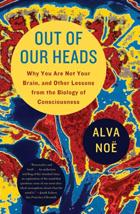A Review of "Out of Our Heads: Why You Are Not Your Brain, and Other Lessons from the Biology of Consciousness" by Alva Noe
 Philosopher Alva Noë tackles the age-old question of "what is consciousness?" in this book. Many astute observers of the psychological scene from William James to B. F. Skinner have weighed in on the question. Julian Jaynes, whose book on consciousness was a finalist for the National Book Award in 1978, reached the creative conclusion that consciousness arose relatively late in human evolution (around 5000 BCE), when we began to internalize dictates from the Gods. Noë contends, as behaviorists have for a long time, that consciousness is not an internalized "thing," whether conceived of in the mind or in the brain. Rather, consciousness is the "interplay among brain, body and world" (p. 175). Hence, the title of the book.
Philosopher Alva Noë tackles the age-old question of "what is consciousness?" in this book. Many astute observers of the psychological scene from William James to B. F. Skinner have weighed in on the question. Julian Jaynes, whose book on consciousness was a finalist for the National Book Award in 1978, reached the creative conclusion that consciousness arose relatively late in human evolution (around 5000 BCE), when we began to internalize dictates from the Gods. Noë contends, as behaviorists have for a long time, that consciousness is not an internalized "thing," whether conceived of in the mind or in the brain. Rather, consciousness is the "interplay among brain, body and world" (p. 175). Hence, the title of the book.
Consciousness has an uneven history in psychology. Among the first topics of interest to early experimentalists, it fell in disfavor as the basis for psychology under the objective eye of John B. Watson, the father of behaviorism. It would be misleading, however, to say that consciousness ever lost its allure in either the discipline of psychology or with the general public during those years when behaviorism reigned supreme - between about 1920 and 1970. Freud’s psychoanalysis was always hanging around, touting the role of the antithesis of consciousness, the unconscious mind, in determining behavior. "States of consciousness," too, were, and are, popular psychological topics, be they sleep, coma, psychosis, or chemically induced ones. It seems, however, that it is easier for psychologists to define the absence of consciousness than its presence.
As noted in the first paragraph, Noë has in common with contemporary behaviorists a healthy skepticism about consciousness and the belief that environment, brain, and body are the joint determiners of our actions. He differs from the behaviorists in that he seems to cling to the concept of consciousness, although it is not clear what function it serves. Also unclear is his position on the concept of mind. To the extent that contemporary behaviorists consider mind and consciousness at all, it is with how we use the words mind and consciousness. These behaviorists examine the circumstances that lead us to describe these words reflecting those two rejected entities.
The book is comprised of eight chapters and an epilogue. The best chapter is the third, in which Noë discusses the “dynamics of consciousness,” very clearly laying out the book’s central theme. After this is done, I was expecting further development, elaboration, and refinement of the theme in subsequent chapters. That was not the case. Rather, the same general theme is repeated in each of those other chapters, albeit with other examples from the behavioral neurosciences of successes of the book’s theme and failures of traditional views of consciousness. The repetition and failure to come to closure on any particular issue beyond the general one made for a disappointing read.
For an overview of nontraditional thinking about consciousness, I recommend reading the third chapter of this book, but then switching to the first few chapters of Julian Jaynes’s creative book. To go further into the notion of consciousness as the interaction of organism and environment, Skinner’s Science and Human Behavior (1953) or, for those with a strong background in behaviorism, Verbal Behavior (1957) are both excellent.



